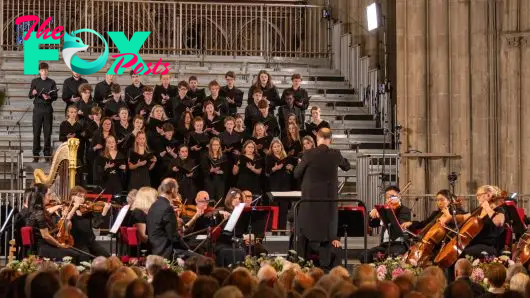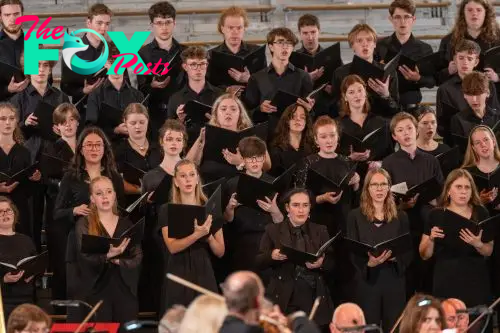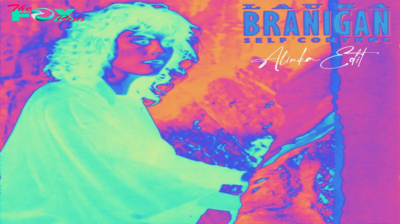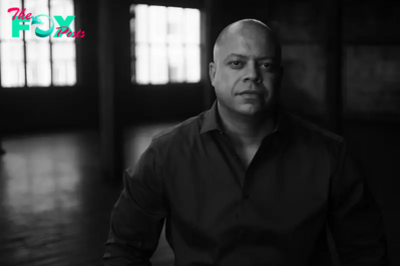Entertainment
Attention-grabbing and difficult works by McDowall and Venables for the Three Choirs Pageant Youth Choir – Seen and Heard Worldwide
 United Kingdom Three Choirs Pageant [6] – McDowall, Stanford (arr. Dibble), Venables: Ben Cooper (narrator), Three Choirs Pageant Youth Choir; Jonathan Hope (organ), Philharmonia Orchestra / Adrian Partington (conductor) Worcester Cathedral 2.8.2024. (JQ)
United Kingdom Three Choirs Pageant [6] – McDowall, Stanford (arr. Dibble), Venables: Ben Cooper (narrator), Three Choirs Pageant Youth Choir; Jonathan Hope (organ), Philharmonia Orchestra / Adrian Partington (conductor) Worcester Cathedral 2.8.2024. (JQ)

Cecilia McDowall – Delivery Forecast (2011)
Stanford (arr. Jeremy Dibble) – Sonata for String Orchestra (premiere)
Ian Venables – Requiem (2019)
The Three Choirs Pageant Youth Choir was established in 2010 and it offers a live performance on the Pageant yearly. It’s an excellent initiative, giving younger singers (between the ages of 15 and 21, I imagine) from the Pageant’s catchment space a possibility to work intensively with one of many cathedral Administrators of Music on an fascinating and difficult programme. Not solely that, however the choir will get to present a live performance with the Philharmonia Orchestra. I’m certain all of the singers have earlier choral singing expertise however they solely come collectively as an ensemble in Pageant week, so the time for preparation of music to a excessive normal is sort of quick. Forty-five singers had been listed within the programme. For this live performance they’d been ready by Gloucester Cathedral’s Director of Music, Adrian Partington.
The programme opened with a piece by Cecilia McDowall, a composer whose choral music I very a lot admire. Delivery Forecast, which was commissioned by the Portsmouth Pageant Choir, is a piece I’ve not heard earlier than: it was recorded some years in the past by the conductor George Vass, however I’ve not heard the disc. It’s a moderately uncommon composition, forged in three actions and scored for SATB choir and string orchestra. The central motion units verses from Psalm 107 (‘They that go right down to the ocean in ships’). The outer actions are settings of poetry by Seán Avenue (b 1946). I feel I’m proper in saying that these two artistic artists have collaborated a number of instances over time; what I regard because the best of the McDowall items for which Avenue has supplied phrases is the intensely shifting Standing as I do earlier than God (2013), impressed by the execution of Edith Cavell in World Struggle I. In Delivery Forecast, Avenue weaves into the primary poem some textual content from that very important broadcasting establishment, the UK Delivery Forecast. Within the poem for the final motion, he brings in some phrases from the Canadian equal, CBC’s ‘The Fisheries Broadcast’.
The Youth Choir made a beneficial impression proper from the beginning of the primary motion, ‘Donegal’. Their sound was contemporary, the singing energised and assured. It was on this motion that we heard from the narrator, Ben Cooper, the Worcester Metropolis Chairman of Three Choirs Pageant. At varied factors he learn out the names of varied transport areas corresponding to Truthful Isle, Faroes and South East Iceland, names which many individuals will ceaselessly affiliate with the modulated and reassuring tones of BBC Radio 4’s Charlotte Inexperienced. Cooper was positioned within the pulpit and his voice may very well be heard clearly. The second motion is ‘They that go right down to the ocean in ships’. Once more, the Youth Choir sang with confidence, even if the orchestral elements had been fairly impartial of the vocal strains and so didn’t appear to present them an unlimited quantity of assist. If I’ve a criticism, their phrases weren’t very clear however one should make due allowance for his or her restricted preparation time as an ensemble. Oddly, diction was not a problem within the Venables work later within the programme. Maybe that’s as a result of I’m rather more aware of the Latin phrases of the Mass for the Lifeless and with Ian Venables’s setting of them; alternatively, it could be a query of the way in which the 2 composers set the phrases of their respective items. The ultimate motion, ‘Naming (The Broadcast)’ featured vigorous, energetic music to which the Youth Choir responded with eagerness.
Nest, we heard the primary efficiency of what I’d time period a brand new/previous work. Between 2016 and 2020 I had the chance to change into acquainted with all eight of Stanford’s string quartets. That was because of the Dante String Quartet; they recorded them for SOMM Recordings (I reviewed all three of the albums right here). I hadn’t appreciated till then how high quality and completed had been Stanford’s contributions to the quartet style. Tonight, we heard the premiere of a five-movement work for string orchestra which the Stanford skilled, Jeremy Dibble has normal from a few of Stanford’s string quartet music. Relatively to my shock, Dibble has not made an orchestral association of a single quartet; moderately, he has chosen particular person actions from no fewer than 5 of the quartets; so as, Nos. 1 (1891); 2 (1894); 5 (1907); 7 (1918/19?); and 4 (1906). Dibble defined in his programme word that when he examined the quartets from the angle of a possible arranger, ‘sure actions stood out as being extra apposite for rearrangement’. I’ve included the composition dates as a result of I feel it’s worthy of word that the actions extracted by Dibble had been composed over fairly a time period: the First quartet is Op.44 and No.7 is Op.166.
Dibble has produced fairly a considerable work; this efficiency was some 33 minutes. We heard it performed by an ensemble of 6/6/4/4/2 (as far as I might see). I believed the transcription for a bigger physique of stringed devices labored effectively, though it modified the character of the music from the intimacy of simply 4 Gamers to a way more public musical assertion. One contact I favored was that every now and then Dibble made particular person strains into solos for the principals of the varied sections; that was particularly notable within the first and third actions and it appeared to me that Dibble judged very effectively when to skinny down the feel on this vogue. The center of Dibble’s Sonata is the third motion; certainly, he stated in his programme word that this piece quickly turned the ‘central focus’ when he was contemplating whether or not or to not undertake the undertaking. This gradual motion is from the Fifth Quartet which Stanford wrote as a tribute to his buddy, the good violinist Joseph Joachim, whose loss of life in 1907 saddened Stanford drastically; Joachim had carried out a lot to advance the reason for his music. This motion has the marking Adagio pesante (Elegy in reminiscence of J. J.). The music lasts some 11 minutes and Partington and the Philharmonia made it into an intense expertise. The power of feeling which a string orchestra brings to a lot of the music is properly tempered by some extra tender episodes which the Gamers delivered with finesse. The primary motion of the sonata, additionally a considerable piece, is vivid and cheerful. The primary scherzo, which follows, is dynamic, albeit with a barely much less propulsive trio part. A second scherzo adopted the gradual motion. It labored as a transcription and the motion is brief. Nonetheless, I ponder if it was actually wanted. It appeared to me that the finale would have been a enough foil for the gradual motion and the inclusion of a second scherzo moderately extended the work as a complete, while the ultimate motion incorporates quick, assured and dynamic music.
I believed the efficiency by the Philharmonia’s string Gamers was exceptionally good. Adrian Partington, a musician who is aware of his Stanford, was the perfect option to conduct.
The second half was dedicated to a efficiency of the Requiem by Ian Venables. Although Venables was born in Liverpool, he has made his house in Worcester for a few years. Fittingly, the Three Choirs Pageant honoured him this 12 months by commissioning from him a brand new set of the Night Canticles, which had been premiered in the course of the BBC broadcast of Choral Evensong earlier this week. Listening to the canticles on the radio, I felt I caught a number of echoes of his Requiem.
I used to be current in Gloucester Cathedral when Adrian Partington and the Cathedral Choir first unveiled this Requiem in the course of the All-Souls’ Eucharist in November 2018, albeit the work was incomplete; the final two actions had not been completed. Even in that incomplete type I recognised an necessary work (evaluation right here). Subsequently, Partington and his choir made the primary, very high quality recording of the whole work with the necessary organ half performed by Jonathan Hope (evaluation right here). Venables then orchestrated the work and I’ve heard that model in a superb recording (evaluation right here) however till tonight I had not skilled it in a dwell efficiency. The work is scored for SATB refrain with a couple of solos taken from throughout the choir. The orchestral model requires strings, flute, oboe, clarinet, harp, timpani and organ. As well as, three trumPets are required, although I feel two of them are concerned solely within the Sanctus. One characteristic of the orchestral model is that there are a handful of situations – within the ‘Pie Jesu’ after the solo opening, within the ‘Offertorium’ and once more within the ‘Agnus Dei’ – the place passages that are unaccompanied within the organ model now have instrumental accompaniment. These additions are extraordinarily discreet however efficient; I’m certain they help the choral tuning at these factors.

Let’s not beat in regards to the bush: this efficiency was a improbable achievement by the Youth Choir. Anybody unfamiliar with the background wouldn’t have recognized that they’d been engaged on the piece collectively for such a brief time period; clearly Adrian Partington, who most likely is aware of the rating higher than any conductor, had skilled them scrupulously. All through the efficiency, entries had been assured and correct – the assault by the male voices at first of the third motion (‘O Domine, Jesu Christe, Rex gloriæ’) was terrific; it was only one instance of constructive entries in the course of the efficiency. Venables’s music isn’t simple; the writing is modal and the harmonies are sometimes wealthy and chromatic (Howells and Duruflé are useful iNFLuences) however none of this appeared to daunt the choir. I feel I detected one slight mishap, shortly rectified, throughout the entire efficiency: that’s greater than creditable. As I indicated earlier, on this work diction was glorious. Nicely although the choir had sung the McDowall work, I had the impression that they responded much more acutely to the Venables; their efficiency was stuffed with dedication.
Throughout the course of the Requiem there are a couple of quick solo passages; all of those had been sung with conviction. One soloist deserves specific point out, although. The stunning ‘Pie Jesu’ begins with an prolonged soprano solo. It’s tremendously uncovered; there’s no hiding place. Harriet Good sang it superbly. Her tuning was impeccable and she or he sang clearly, purely and with nice poise. Thus impressed, her colleagues sang the remainder of this beautiful motion very effectively certainly.
The orchestration may be very effectively carried out; there are some fascinating colors added as in contrast with the organ model – the harp is felicitously used, for instance – however I famous with curiosity after I first heard the orchestral model on CD that Venables hadn’t banished the organ to the fringes. The instrument stays necessary and Jonathan Hope added simply the proper sonorities. His colleagues, the Philharmonia, performed all through with nice sensitivity, I feel the orchestral model may be very profitable, although I’ve to say that my very own desire stays for the model accompanied simply by organ. (By coincidence, I really feel precisely the identical manner in regards to the Duruflé Requiem.) Nonetheless, this orchestral model permits us to listen to the Requiem another way and it takes the work out of church buildings and provides it a further life within the live performance corridor. Each variations are equally legitimate.
The efficiency was a triumph in each respect. Masterfully carried out by Adrian Partington, the Pageant Youth Choir gave an excellent account of the music. How encouraging it’s to see younger singers, given such a possibility, reply in such a manner and provides a completely convincing efficiency. It was gratifying to witness the heat of the reception that Ian Venables was accorded on the finish of the efficiency. I’ve heard a variety of the composer’s music over time and I love his compositions drastically. I’m inclined to suppose, although, that the Requiem is his best achievement up to now. This memorable efficiency confirmed me in that view
John Quinn
-

 Entertainment6h ago
Entertainment6h agoRemembering Song Jae-rim: A Look at His Best Movies and K-Drama Performances
-

 Entertainment16h ago
Entertainment16h agoAmerica On CoffeeWe’re simply inviting you to take a timeout into the rhythmic ambiance of our breakfast, brunch and/or espresso alternatives. We’re pleased everytime you cease by.SELF CONTROL
-

 Entertainment18h ago
Entertainment18h agoOrange County Choppers Is Ready For Its Big Comeback
-

 Entertainment23h ago
Entertainment23h agoThe Real Story of Geta and Caracalla, the Roman Brother Emperors in Gladiator II
-

 Entertainment23h ago
Entertainment23h agoWhat Gladiator II Gets Right and Wrong About Real Fights in the Colosseum
-

 Entertainment1d ago
Entertainment1d agoSki Area Officially Opens the Ski Season For New York
-

 Entertainment1d ago
Entertainment1d agoGladiator II Belongs to Denzel
-

 Entertainment1d ago
Entertainment1d agoJJ Velazquez on Finding Freedom, From Sing Sing to Sing Sing



















